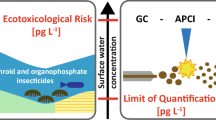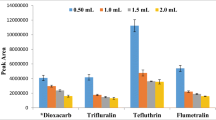Abstract
A study was initiated to investigate a fast and reliable method for the determination of selected systemic insecticides in water matrixes and to evaluate potential sources of bias in their analysis. Acetamiprid, clothianidin, desnitro-imidacloprid, dinotefuran, fipronil, imidacloprid, nitenpyram, thiacloprid, and thiamethoxam were amenable to analysis via on-line sample enrichment hyphenated to ultra-high-performance liquid chromatography tandem mass spectrometry. The selection of on-line solid-phase extraction parameters was dictated by a multicriterion desirability approach. A 2-mL on-line injection volume with a 1500 μL min−1 loading flow rate met the objectives sought in terms of chromatographic requirements, extraction efficiency, sensitivity, and precision. A total analysis time of 8 min per sample was obtained with method limits of detection in the range of 0.1–5 ng L−1 for the scope of targeted analytes. Automation at the sample concentration step yielded intraday and interday precisions in the range of 1–23 and 2–26%, respectively. Factors that could affect the whole method accuracy were further evaluated in matrix-specific experiments. The impact of the initial filtration step on analyte recovery was evaluated in ultra-pure water, tap water, and surface water. Out of the nine membranes tested, glass fiber filters and polyester filters appeared as the most appropriate materials. Sample storage stability was also investigated across the three matrix types; the targeted analytes displayed suitable stability during 28 days at either 4 °C or − 20 °C, with little deviations (± 10%) with respect to the initial T0 concentration. Method applicability was demonstrated in a range of tap water and surface water samples from the province of Québec, Canada. Results from the present survey indicated a predominance of thiamethoxam (< 0.5–10 and 3–61 ng L−1 in tap water and river water, respectively), clothianidin (< 0.5–6 and 2–88 ng L−1 in tap water and river water, respectively), and imidacloprid (< 0.1–1 and 0.8–38 ng L−1 in tap water and river water, respectively) among the targeted analytes.

ᅟ
Development of solid-phase extraction coupled on-line to UHPLC-MS/MS for the rapid screening of systemic insecticides in water.



Similar content being viewed by others
References
Matsuda K, Buckingham SD, Kleier D, Rauh JJ, Grauso M, Sattelle DB. Neonicotinoids: insecticides acting on insect nicotinic acetylcholine receptors. Trends Pharmacol Sci. 2001;22(11):573–80.
Tomizawa M, Casida JE. Structure and diversity of insect nicotinic acetylcholine receptors. Pestic Biochem Physiol. 2001;57:914–22.
Simon-Delso N, Amaral-Rogers V, Belzunces LP, Bonmatin JM. Systemic insecticides (neonicotinoids and fenopril): trends, uses, mode of action and metabolites. Environ Sci Pollut Res Int. 2015;22:5–34.
David A, Botias C, Abdul-Sada A, Goulson D, Hill EM. Sensitive determination of mixtures of neonicotinoid and fungicide residues in pollen and single bumblebees using a scaled down QuEChERS method for exposure assessment. Anal Bioanal Chem. 2015;407(26):8151–62.
Tison L, Hahn ML, Holtz S, Rossner A, Greggers U, Bischoff G, et al. Honey bees’ behavior is impaired by chronic exposure to the neonicotinoid thiacloprid in the field. Environ Sci Technol. 2016;50(13):7218–27.
Scholer J, Krischik V. Chronic exposure of imidacloprid and clothianidin reduce queen survival, foraging, and nectar storing in colonies of Bombus impatiens. PLoS One. 2014;9(3):e91573.
Cabrera AR, Almanza MT, Cutler GC, Fischer DL, Hinarejos S, Lewis G, et al. Initial recommendations for higher-tier risk assessment protocols for bumble bees, Bombus spp. (Hymenoptera: Apidae). Integr Environ Assess Manag. 2016;12(2):222–9.
Gibbons D, Morrissey C, Mineau P. A review of the direct and indirect effects of neonicotinoids and fipronil on vertebrate wildlife. Environ Sci Pollut Res Int. 2015;22(1):103–18.
Hladik ML, Kolpin DW, Kuivila KM. Widespread occurrence of neonicotinoid insecticides in streams in a high corn and soybean producing region,USA. Environ Pollut. 2014;193:189–96.
Wang W, Li Y, Wu Q, Wang C, Zang X, Wang Z. Extraction of neonicotinoid insecticides from environmental water samples with magnetic graphene nanoparticles as adsorbent followed by determination with HPLC. Anal Methods. 2012;4(3):766.
Morrissey CA, Mineau P, Devries JH, Sanchez-Bayo F, Liess M, Cavallaro MC, et al. Neonicotinoid contamination of global surface waters and associated risk to aquatic invertebrates: a review. Environ Int. 2015;74:291–303.
Main AR, Michel NL, Headley JV, Peru KM, Morrissey CA. Ecological and landscape drivers of neonicotinoid insecticide detections and concentrations in Canada’s Prairie wetlands. Environ Sci Technol. 2015;49(14):8367–76.
Schaafsma A, Limay-Rios V, Baute T, Smith J, Xue Y. Neonicotinoid insecticide residues in surface water and soil associated with commercial maize (corn) fields in Southwestern Ontario. PLoS One. 2015;10(2):e0118139.
Chen M, Tao L, McLean J, Lu C. Quantitative analysis of neonicotinoid insecticide residues in foods: implication for dietary exposures. J Agric Food Chem. 2014;62(26):6082–90.
Zhang F, Li Y, Yu C, Pan C. Determination of six neonicotinoid insecticides residues in spinach, cucumber, apple and pomelo by QuEChERS method and LC-MS/MS. Bull Environ Contam Toxicol. 2012;88(6):885–90.
Ferrer I, Thurman EM, Fernández-Alba AR. Quantitation and accurate mass analysis of pesticides in vegetables by LC/TOF-MS. Anal Chem. 2005;77(9):2818–25.
Xiao Z, Yang Y, Li Y, Fan X, Ding S. Determination of neonicotinoid insecticides residues in eels using subcritical water extraction and ultra-performance liquid chromatography-tandem mass spectrometry. Anal Chim Acta. 2013;777:32–40.
Seccia S, Fidente P, Montesano D, Morrica P. Determination of neonicotinoid insecticides residues in bovine milk samples by solid-phase extraction clean-up and liquid chromatography with diode-array detection. J Chromatogr A. 2008;1214(1–2):115–20.
Xiao Z, Li X, Wang X, Shen J, Ding S. Determination of neonicotinoid insecticides residues in bovine tissues by pressurized solvent extraction and liquid chromatography-tandem mass spectrometry. J Chromatogr B. 2011;879(1):117–22.
Taira K, Fujioka K, Aoyama Y. Qualitative profiling and quantification of neonicotinoid metabolites in human urine by liquid chromatography coupled with mass spectrometry. PLoS One. 2013;8(11):e80332. https://doi.org/10.1371/journal.pone.0080332
Yamamuro T, Ohta H, Aoyama M, Watanabe D. Simultaneous determination of neonicotinoid insecticides in human serum and urine using diatomaceous earth-assisted extraction and liquid chromatography-tandem mass spectrometry. J Chromatogr B. 2014;969:85–94.
Bonmatin JM, Giorio C, Girolami V, Goulson D, Kreutzweiser DP, Krupke C, et al. Environmental fate and exposure; neonicotinoids and fipronil. Environ Sci Pollut Res Int. 2015;22(1):35–67.
van der Sluijs JP, Amaral-Rogers V, Belzunces LP, Bijleveld van Lexmond MF, Bonmatin JM, Chagnon M, et al. Conclusions of the Worldwide Integrated Assessment on the risks of neonicotinoids and fipronil to biodiversity and ecosystem functioning. Environ Sci Pollut Res Int. 2015;22(1):148–54.
Dujakovic N, Grujic S, Radisic M, Vasiljevic T, Lausevic M. Determination of pesticides in surface and ground waters by liquid chromatography-electrospray-tandem mass spectrometry. Anal Chim Acta. 2010;678(1):63–72.
Hladik ML, Calhoun, D.L. Analysis of the herbicide diuron, three diuron degradates and six neonicotinoid insecticides in water—method details and application to two Georgia streams: U.S. Geological Survey. Scientific Investigations Report 2012-5206, 10p
Hao C, Morse D, Zhao X, Sui L. Liquid chromatography/tandem mass spectrometry analysis of neonicotinoids in environmental water. Rapid Commun Mass Spectrom. 2015;29(23):2225–32.
Seccia S, Fidente P, Barbini DA, Morrica P. Multiresidue determination of nicotinoid insecticide residues in drinking water by liquid chromatography with electrospray ionization mass spectrometry. Anal Chim Acta. 2005;553(1–2):21–6. https://doi.org/10.1016/j.aca.2005.08.006.
Garcia-Ac A, Segura PA, Viglino L, Furtos A, Gagnon C, Prévost M, et al. On-line solid-phase extraction of large-volume injections coupled to liquid chromatography-tandem mass spectrometry for the quantitation and confirmation of 14 selected trace organic contaminants in drinking and surface water. J Chromatogr A. 2009;1216(48):8518–27.
Fayad PB, Prévost M, Sauvé S. On-line solid-phase extraction coupled to liquid chromatography tandem mass spectrometry optimized for the analysis of steroid hormones in urban wastewaters. Talanta. 2013;115:349–60.
Valsecchi S, Polesello S, Mazzoni M, Rusconi M, Petrovic M. On-line sample extraction and purification for the LC–MS determination of emerging contaminants in environmental samples. Trends Environ Anal Chem. 2015;8:27–37.
Munoz G, Labadie P, Geneste E, Pardon P, Tartu S, Chastel O, et al. Biomonitoring of fluoroalkylated substances in Antarctica seabird plasma: development and validation of a fast and rugged method using on-line concentration liquid chromatography tandem mass spectrometry. J Chromatogr A. 2017;1513:107–17.
Giroux I. Présence de pesticides dans l’eau au Québec: Portrait et tendances dans les zones de maïs et de soya -2011 à 2014. Québec, ministère du Développement durable, de l’Environnement et de la Lutte contre les changements climatique. Direction du suivi de l’état de l’environnement; 2015. p. 47.
Bezerra MA, Santelli RE, Oliveira EP, Villar LS, Escaleira LA. Response surface methodology (RSM) as a tool for optimization in analytical chemistry. Talanta. 2008;76(5):965–77.
Munoz G, Vo Duy S, Budzinski H, Labadie P, Liu J, Sauvé S. Quantitative analysis of poly- and perfluoroalkyl compounds in water matrices using high resolution mass spectrometry: optimization for a laser diode thermal desorption method. Anal Chim Acta. 2015;881:98–106.
Bekele EA, Annaratone CE, Hertog ML, Nicolai BM, Geeraerd AH. Multi-response optimization of the extraction and derivatization protocol of selected polar metabolites from apple fruit tissue for GC-MS analysis. Anal Chim Acta. 2014;824:42–56. https://doi.org/10.1016/j.aca.2014.03.030.
Bonino, E. Seventh Commission Directive 96/45/EC of 2 July 1996 relating to methods of analysis necessary for checking the composition of cosmetic products. Off J Eur Communities. 1996;213(8).
Papai ZS, Pap TL. Analysis of peak asymmetry in chromatography. J Chromatogr A. 2002;953:8.
Dolan JW. Why do peaks tail? LCGC N Am 2003;21(7):612–16.
Thompson M, Ellison SLR, Wood R. Harmonized guidelines for single-laboratory validation of methods of analysis. Pure Appl Chem. 2002;74(5):20.
Munoz G, Desrosiers M, Duy SV, Labadie P, Budzinski H, Liu J, et al. Environmental occurrence of perfluoroalkyl acids and novel fluorotelomer surfactants in the freshwater fish Catostomus commersonii and sediments following firefighting foam deployment at the Lac-Megantic railway accident. Environ Sci Technol. 2017;51(3):1231–40.
Munoz G, Duy SV, Labadie P, Botta F, Budzinski H, Lestremau F, et al. Analysis of zwitterionic, cationic, and anionic poly- and perfluoroalkyl surfactants in sediments by liquid chromatography polarity-switching electrospray ionization coupled to high resolution mass spectrometry. Talanta. 2016;152:447–56.
Darwano H, Duy SV, Sauvé S. A new protocol for the analysis of pharmaceuticals, pesticides, and hormones in sediments and suspended particulate matter from rivers and municipal wastewaters. Arch Environ Contam Toxicol. 2014;66(4):582–93.
Guidance document on analytical quality control and method validation procedures for pesticides residues analysis in food and feed, SANTE/11945/2015 (Supersedes SANCO/12571/2013). 2015; European Commission Directorate-General for Health and Food Safety.
Kasiotis K, Anagnostopoulos C, Anastasiadou P, Machera K. Pesticide residues in honeybees, honey and bee pollen by LC-MS/MS screening: reported death incidents in honeybees. Sci Total Environ. 2014;485:633–42.
Masia A, Ibanez M, Blasco C, Sancho JV, Pico Y, Hernandez F. Combined use of liquid chromatography triple quadrupole mass spectrometry and liquid chromatography quadrupole time-of-flight mass spectrometry in systematic screening of pesticides and other contaminants in water samples. Anal Chim Acta. 2013;761:117–27.
Naldi AC, Fayad PB, Prévost M, Sauvé S. Analysis of steroid hormones and their conjugated forms in water and urine by on-line solid-phase extraction coupled to liquid chromatography tandem mass spectrometry. Chem Cent J. 2016;10:30.
Munoz G, Vo Duy S, Roy-Lachapelle A, Husk B, Sauvé S. Analysis of individual and total microcystins in surface water by on-line preconcentration and desalting coupled to liquid chromatography tandem mass spectrometry. J Chromatogr A. 2017;1516:9–20.
Lu Z, Challis JK, Wong CS. Quantum yields for direct photolysis of neonicotinoid insecticides in water: implications for exposure to nontarget aquatic organisms. Environ Sci Technol Lett. 2015;2(7):188–92.
Sadaria AM, Supowit SD, Halden RU. Mass balance assessment for six neonicotinoid insecticides during conventional wastewater and wetland treatment: nationwide reconnaissance in United States wastewater. Environ Sci Technol. 2016;50(12):6199–206.
Funding
We thank the Natural Sciences and Engineering Research Council of Canada (NSERC), the Quebec Research Fund (FRQ), and the Canada Foundation for Innovation (CFI) for their financial support. The authors acknowledge technical support from Thermo Fisher Scientific. Conacyt (Consejo Nacional de Ciencia y Tecnología, Mexico City, Mexico) is acknowledged for the PhD scholarship awarded to Juan Manuel Montiel León.
Author information
Authors and Affiliations
Corresponding author
Ethics declarations
Conflict of interest
The authors declare that they have no conflict of interest.
Electronic supplementary material
ESM 1
(PDF 263 kb)
Rights and permissions
About this article
Cite this article
Montiel-León, J.M., Duy, S.V., Munoz, G. et al. Evaluation of on-line concentration coupled to liquid chromatography tandem mass spectrometry for the quantification of neonicotinoids and fipronil in surface water and tap water. Anal Bioanal Chem 410, 2765–2779 (2018). https://doi.org/10.1007/s00216-018-0957-2
Received:
Revised:
Accepted:
Published:
Issue Date:
DOI: https://doi.org/10.1007/s00216-018-0957-2




